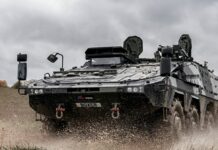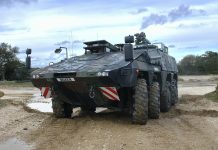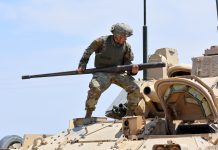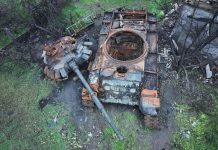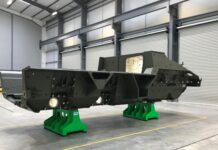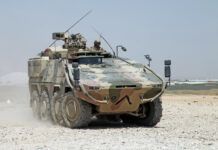The UK is modernising its land capabilities. A central outcome will be establishing and equipping an all-new formation for the British Army – the STRIKE Brigade.
The UK’s 2015 Strategic Defence and Security Review (SDSR) introduced the ‘Army 2020 Refine’ vision, a significant element of which was the creation of two new ‘STRIKE Brigades’, to be formed by 2025 and comprising 5,000 personnel each. These STRIKE Brigades seek to field a versatile medium weight force that can self-deploy to deliver decisive effect at distances up to 2,000 km, notionally combining the lethality and survivability of heavier formations with broader utility across low, medium and high intensity operations.
Introduction to STRIKE
The intent is an agile force, expeditionary by design and better able to respond to scenarios the Army is likely to face. In the high intensity scenario, STRIKE would be the UK’s first responders, deploying rapidly to meet with a (Russian) aggressor, reconnoitre, disrupt and delay without support for up to 10 days, to allow heavier and slower-to-deploy Armoured Infantry (AI) formations and allied forces to reinforce.

A core concept is that of dispersed operation. STRIKE will not seek a conventional confrontation, instead manoeuvring in de-centralised Company or smaller groups, concentrating on the force-multiplying effects of accompanying assets including missile and rocket artillery. Each Brigade will therefore operate over a relatively large area for its size – some 100 km of frontage and up to 100 km depth.
STRIKE is in many ways a heavy reconnaissance screen, locating and directing fires whilst conducting limited probing attacks to disrupt and delay enemy formations. Evoking a contemporary, and heavier, take on disruptive commando raiding behind the lines, it seeks to be an agile force that leverages force multipliers to conduct the battle.
Equipping the STRIKE Formation
STRIKE is currently being equipped with two core families of armoured fighting vehicles (AFV): the General Dynamics European Land Systems UK (GDLS-UK) AJAX and the ARTEC BOXER.
AJAX is both the name of a family of vehicles, and the designation for the primary armoured reconnaissance variant. A development of the ASCOD platform, also used by Austria and Spain as the ULAN and PIZARRO Infantry Fighting Vehicles (IFV) respectively, AJAX is being fielded in six variants; AJAX (reconnaissance), ARES (APC), ATHENA (C2), ARGUS (engineering), APOLLO (repair) and ATLAS (recovery).
The AJAX variant is equipped with a Lockheed Martin turret mounting the CT40, a cased telescoped 40mm gun/ammunition system developed by CTI International. CT40 uses a 40 × 255mm cased-telescoped ammunition design to provide a greater level of firepower than conventional medium calibres. The 40 mm projectiles are loaded within a 65 × 225mm case and surrounded by propellant. This configuration makes CTA rounds about 35% smaller in volume, than conventional rounds of the same calibre.
The stabilised CT40 armament is a step-change in capability for the British Army over the former armoured reconnaissance platform, the CVR(T). Also to be fielded on the UK’s WARRIOR, CT40 provides overmatch against all peer conventional AFVs, and even against some legacy MBTs.
AJAX is the first truly digital vehicle the British Army has acquired, developed from the outset to be generic vehicle architecture (GVA) compliant, with high levels of on- and off-platform data-sharing. Designed for growth, the vehicle’s architecture accommodates a 500% future increase in bandwidth. Situational awareness and surveillance systems are also the most capable fielded by the UK, critical for the vehicle’s role as the Army’s armoured reconnaissance platform.

BOXER is the second major component of the STRIKE formation, ordered in a £2.8Bn contract awarded in November 2019 for over 500 vehicles. Forming the core of the fighting force and carrying the bulk of its infantry component, BOXER is the culmination of a decades-long series of programmes to provide a wheeled protected mobility capability to the Army.
BOXER is unique in that it uses a modular design, splitting the automotive base chassis, called the Drive Module, from the mission-specific compartment at the rear, called the Mission Module. The Drive Module encompasses the chassis, drivetrain and driver’s compartment, and is entirely independent. Mission Modules are mounted on the rear of the vehicle and can be changed quickly in the field, giving a range of logistical benefits and enabling rapid reconfiguration to meet mission requirements.
Numerous modules have been developed for BOXER, and the UK plans to acquire the APC, command, ambulance, and recovery versions. Other users, including Australia, Lithuania and Algeria, have selected versions with medium-calibre turrets for much-enhanced firepower, but the UK is not pursuing this capability.
Supporting fires will be crucial to the success of STRIKE. Indeed, as a comparatively lightly armed and armoured force, much of its effect is achieved by fires rather than combat vehicles. One of the critical capabilities for this will be the Army’s new self-propelled 155mm howitzer, being procured under the Mobile Fires Platform (MFP) programme and replacing the largely obsolete AS90 fleet.
MFP is to deliver a minimum range of 30 km including multiple-round simultaneous-impact fire missions. Fast engagement and redeployment, to avoid counter-battery fire, is critical, with a requirement to conduct a fire mission in under four and a half minutes, including emplacement, two minutes of firing, and removal to at least 550 m from the firing position. Service entry is planned for mid-2028, with a full operational capability in 2032.
Alongside the tube artillery is a programme for enhanced long and medium-range rocket artillery under the Land Deep Fires Programme (LDFP) and its component parts, the Deep Fires Rocket System (DFRS) and Land Precision STRIKE (LPS). DFRS seeks a longer-range rocket system; rumour suggests the Lockheed Martin Precision STRIKE Missile (PrSM) missile from the US. LPS is a medium range rocket to be developed for the UK’s M270 system. Collectively, these programmes would significantly increase UK indirect fire capabilities.
Enduring Concerns

As a vision, STRIKE is a compelling and far more sensible aspiration for the UK’s limited funds and military capabilities than the heavier Cold War-esque formations it tries also to maintain. STRIKE addresses the conflicts and scenarios the UK may face in the future far better than existing, purely armoured infantry formations would. The core vehicles acquired for STRIKE are highly capable and represent genuinely good capabilities for the soldiers that will use them. As a roadmap, STRIKE is the right move for the British Army and UK capability.
The realisation of STRIKE as it stands in 2020 is, however, somewhat less clear-cut.
With AJAX’s 40 mm cannon representing the largest armament, the formation has been accused of lacking direct firepower. Despite calls for a 105 mm or 120 mm armed ‘tank destroyer’ vehicle to shore up this capability, studies to date suggest existing capabilities are enough. CT40 is one of the most capable medium calibre armaments available, and overmatches essentially any threat vehicle’s armour short of contemporary MBTs. Even these would suffer significant damage and could be rendered a mobility or mission kill under sustained fire. Studies conducted by the UK’s dstl concluded that existing capabilities around the CT40 gun overmatch peer threat armour.
Beyond the weapons on and in the BOXER and AJAX vehicles themselves, the Army envisages STRIKE using ‘Joint Effects’ for much of its offensive action – air, joint fires and multi-domain resources including electronic warfare. Divisional fires attached to the Brigades would include 155mm artillery and medium/long range rocketry, heavily supported by F-35B and APACHE aircraft as well as submarine launched cruise missiles.
The Army calls this ‘Integrated Effect’, and it is certainly, theoretically, compelling. The concern is that much of this relies on capabilities that either do not exist or would be unlikely to be available in many of the envisaged conflicts. For example, the West often relies on the assumption that, like recent asymmetric conflicts in the Middle East and North Africa, it will enjoy an entirely permissive air environment and can rely on aircraft to deliver many of the desired effects. But Russia presents arguably the most capable and largest air defence network in the world, and the likelihood of even limited air support during an initial high tempo engagement of the type STRIKE is intended to conduct is very low. This would be broadly true of many of the UK’s peer threats. As the forward element of a UK force, or the lead screening element of a larger force, STRIKE is expected to operate in near isolation, in which context it lacks organic supporting capabilities.
The UK also lacks air defence capabilities: beyond a limited selection of dated VSHORAD RAPIER FS(C) and STARSTREAK systems the country is essentially without defence against hostile aircraft. British doctrine assumes allied coverage for such scenarios, but such assumptions are hazardous. The Army’s air defence assets have not seen meaningful upgrades in decades, and contemporary threats like swarming drones, low observable aircraft and cruise missiles are basically ignored. STRIKE needs its own set of air defence platforms at the very short, short and medium ranges at a minimum – including counter rocket, artillery and mortar (C-RAM) – or it will be totally exposed and vulnerable to hostile air and fires.
Within the context of organic fires, STRIKE lacks some required capabilities too. Though tube and rocket artillery are being pursued, further organic fires are required. At a minimum, STRIKE needs 120mm mortar vehicles, new counterbattery radars and dedicated non-line-of-sight anti-tank guided missile vehicles. All of these could be based on BOXER for commonality and ease of logistical support when deployed, and to ensure a baseline mobility is maintained.
Perhaps the biggest unresolved issue though is that of how STRIKE would deploy, either globally for contingent scenarios or regionally to respond to a hostile Russia.
AJAX is the most challenging point in this equation. Technically, it would be nigh-impossible for AJAX to self-deploy as intended of the STRIKE formation. It would suffer enormous mechanical and occupant fatigue over long distances, would travel at a detrimentally slow pace and would suffer significant attrition as vehicles break down or require maintenance. These are intrinsic weaknesses of tracked vehicles, which are inherently biased towards tactical mobility at the cost of strategic mobility.
As such, AJAX’s contribution to the STRIKE formation is incumbent on the availability of transporters to project it. Such transporters are low in number, so much so that the UK would need to use the entirety of its fleet of 92 Oshkosh Heavy Equipment Transporters (HET) and 77 Light Equipment Transporters (LET) just to move AJAX and BOXER vehicles into theatre. This leaves practically no equipment transporters for the Armoured Infantry until they return from deploying STRIKE, significantly delaying any reinforcement of the isolated STRIKE formations.
Whilst BOXER is far more suited to prolonged road movements than its tracked counterpart, it too would be far better off deployed by equipment transporter. Long road marches impart much the same issues as AJAX, being inherent to the movement of armoured vehicles. Moving BOXERs by HET is preferable to ensure the force arrives in theatre in one piece in the best possible condition to undertake prolonged independent operations. At this time, there are no public plans to expand the HET/LET fleets to address this necessity.
The Army remains confident that these are minor issues that will be resolved by further programmes, though cannot explain how it would fulfil them. The Ministry of Defence is critically short on budget and is unable to afford its existing equipment plan, which lacks many of the capabilities discussed. Competing demand in the Armoured Infantry realm for the upgrade of (near obsolete) IFV and MBT platforms, destroys the funding that underpins the STRIKE concept. Without compromise in other areas, STRIKE is likely to fall short of the capable and valuable concept it seeks to realise.
Henry Richardson is a defence consultant specialising in Western land forces and armoured vehicle technology, based in London.



